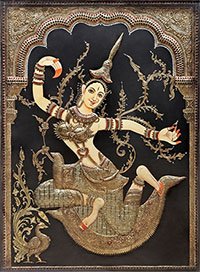Samalamkrita, Sam-alankrita, Samalaṃkṛta, Samalaṅkṛta, Sam-alamkrita, Samalankrita: 5 definitions
Introduction:
Samalamkrita means something in Buddhism, Pali, Hinduism, Sanskrit, Hindi. If you want to know the exact meaning, history, etymology or English translation of this term then check out the descriptions on this page. Add your comment or reference to a book if you want to contribute to this summary article.
The Sanskrit terms Samalaṃkṛta and Samalaṅkṛta can be transliterated into English as Samalamkrta or Samalamkrita or Samalankrta or Samalankrita, using the IAST transliteration scheme (?).
In Hinduism
Sports, Arts and Entertainment (wordly enjoyments)
Source: archive.org: Syainika Sastra of Rudradeva with English Translation (art)Samalaṃkṛta (समलंकृत) refers to “decorating oneself with garlands of flowers, etc.”, according to the Śyainika-śāstra: a Sanskrit treatise dealing with the divisions and benefits of Hunting and Hawking, written by Rājā Rudradeva (or Candradeva) in possibly the 13th century.—Accordingly, [while discussing the conclision of hawking]: “[...] After [listening to music] [the king] should take his bath and anoint his person with sandal, etc. Then, wearing bright apparel and a pearl necklace and garlands of flower (samalaṃkṛta) [sukusumairyathāvatsamalaṃkṛtaḥ], he should repeat his daily prayers. He should then refresh himself with a glass of sherbet of sugar as white as the belly of a goose. [...]”.

This section covers the skills and profiencies of the Kalas (“performing arts”) and Shastras (“sciences”) involving ancient Indian traditions of sports, games, arts, entertainment, love-making and other means of wordly enjoyments. Traditionally these topics were dealt with in Sanskrit treatises explaing the philosophy and the justification of enjoying the pleasures of the senses.
In Buddhism
Mahayana (major branch of Buddhism)
Source: academia.edu: A Study and Translation of the GaganagañjaparipṛcchāSamalaṃkṛta (समलंकृत) refers to “well adorned” (i.e., ‘one whose eloquence is well adorned’), according to the Gaganagañjaparipṛcchā: the eighth chapter of the Mahāsaṃnipāta (a collection of Mahāyāna Buddhist Sūtras).—Accordingly, “Then, they [the twenty-four types of pratibhāna—‘eloquence’] are accomplished by means of the following twenty-four preparations (parikarma). What are the twenty-four? [...] (4) he becomes one who has uninterrupted eloquence since he is not attached to anything in particular; (5) he becomes one who has the eloquence of good explanation since he is the absence of slanderous speech; (6) he becomes one who has profound eloquence since he understands the dependent origination; (7) he becomes one who has eloquence in diversity since he accumulates [the merit] of various kinds of giving; (8) he becomes one whose eloquence is well adorned (samalaṃkṛta) since he gives even his beautifully adorned wife; [...]”.
Source: De Gruyter: A Buddhist Ritual Manual on AgricultureSamalaṃkṛta (समलंकृत) refers to “being embellished with (various jewels and gems)”, according to the Vajratuṇḍasamayakalparāja, an ancient Buddhist ritual manual on agriculture from the 5th-century (or earlier), containing various instructions for the Sangha to provide agriculture-related services to laypeople including rain-making, weather control and crop protection.—Accordingly, “Now the Bhagavān was residing in the abode of Brahmā. [...] All gathered with a great retinue. Vajrapāṇi, the Lord of the Yakṣas, assembled with ten million Yakṣas. Vajradhara, embellished with (samalaṃkṛta) various jewels and gems, with a retinue of a hundred thousand Vidyādharas. [...]”.

Mahayana (महायान, mahāyāna) is a major branch of Buddhism focusing on the path of a Bodhisattva (spiritual aspirants/ enlightened beings). Extant literature is vast and primarely composed in the Sanskrit language. There are many sūtras of which some of the earliest are the various Prajñāpāramitā sūtras.
Languages of India and abroad
Sanskrit dictionary
Source: Cologne Digital Sanskrit Dictionaries: Monier-Williams Sanskrit-English DictionarySamalaṃkṛta (समलंकृत):—[=sam-alaṃkṛta] [from samalaṃ-kṛ] mfn. highly decorated, well adorned, [ib.]
Sanskrit, also spelled संस्कृतम् (saṃskṛtam), is an ancient language of India commonly seen as the grandmother of the Indo-European language family (even English!). Closely allied with Prakrit and Pali, Sanskrit is more exhaustive in both grammar and terms and has the most extensive collection of literature in the world, greatly surpassing its sister-languages Greek and Latin.
Hindi dictionary
Source: DDSA: A practical Hindi-English dictionarySamalaṃkṛta (समलंकृत):—(a) well-decorated, fully adorned, embellished.
...
See also (Relevant definitions)
Partial matches: Alankrita, Alamkrita, Sam.
Full-text: Rasaka, Jrimbhaka, Uragagarbha, Ovattika, Shakrabhilagna, Shilaskandha, Manca, Simhalata, Pralamba, Alam.
Relevant text
Search found 6 books and stories containing Samalamkrita, Sam-alankrita, Samalaṃkṛta, Samalaṅkṛta, Sam-alamkrita, Samalankrita, Sam-alaṃkṛta, Sam-alamkrta, Samalamkrta, Sam-alaṅkṛta, Samalankrta, Sam-alankrta; (plurals include: Samalamkritas, alankritas, Samalaṃkṛtas, Samalaṅkṛtas, alamkritas, Samalankritas, alaṃkṛtas, alamkrtas, Samalamkrtas, alaṅkṛtas, Samalankrtas, alankrtas). You can also click to the full overview containing English textual excerpts. Below are direct links for the most relevant articles:
Garga Samhita (English) (by Danavir Goswami)
Verse 1.9.9 < [Chapter 9 - Description of Vasudeva’s Wedding]
Verses 2.25.15-20 < [Chapter 25 - The Rāsa-dance Pastime]
Alamkaras mentioned by Vamana (by Pratim Bhattacharya)
2: Alaṃkāra-śāstra according to Bharata (2nd century B.C.) < [Chapter 2 - The concept of alaṃkāra in Sanskrit Poetics]
Sahitya-kaumudi by Baladeva Vidyabhushana (by Gaurapada Dāsa)
Text 9.34 < [Chapter 9 - Ornaments of Sound]
The Matsya Purana (critical study) (by Kushal Kalita)
Part 2 - Application of Alaṃkāra (figure of speech) in the Matsyapurāṇa < [Chapter 2 - Literary aspect of the Matsyapurāṇa]
Maha Prajnaparamita Sastra (by Gelongma Karma Migme Chödrön)
III.2: Subjective nature of the appearance of the Buddhas < [Part 4 - Being born into the family of the Bodhisattvas, etc.]
Reverberations of Dharmakirti’s Philosophy (by Birgit Kellner)